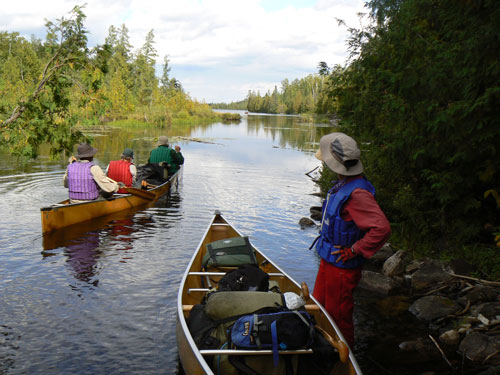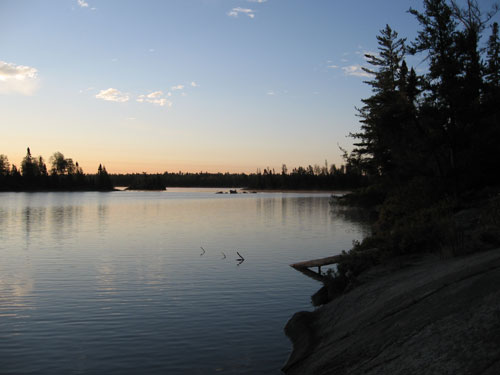Author and Trip Leader:
Reid Priedhorsky,
reid@reidster.net
Participants:
Reid Priedhorsky, Andy Exley, Bill Priedhorsky, Jan Studebaker,
Marilyn Yeamans, Rick Kelley, Dick Opsahl
Reid's Full
Trip Report: click
here
(maps, photos, etc.)
Jan's Photo
Gallery: click
here to view

Particulars:
Seven days of canoeing in the Boundary Waters Canoe Area Wilderness,
northern Minnesota. 27 lakes, 39 miles paddling, 1,700 rods
portaging (that’s 5.3 miles for you landlubbers) in 28 carries, and
5.9 miles day-hiking.
Testimonials:
-
"Terrible conditions ... an
extremely tiring paddle."
— Andy Exley
-
"A pretty stupid idea."
— Rick Kelley
-
"One of the most frightening
experiences of my life."
— Bill Priedhorsky
Weather:
Rotten

This trip was billed as an "easy"
introduction to the beautiful wilderness of northern Minnesota.
Fortunately, this notion was quickly dispelled with a monster
307-rod portage on the first day. Day 2 led us deeper into the BWCAW
under clear skies, but the weather rolled in after supper and it
rained and blew all night and into the morning.
Day 3 was a short but windy series of
three paddles leading us to a campsite with a fine view over
Kekekabic Lake by lunchtime. The weather remained overcast, cold,
and windy, and most folks spend the afternoon reading and hanging
out.
Day 4, our layover day, opened cold
but clear. We spent the day hiking out and back along the Kekekabic
Trail, a brush-chocked path which leads (eventually) to connections
with hundreds of miles of trail along the Canadian border and the
north shore of Lake Superior. But for us, 300 grueling vertical feet
was plenty and we ate lunch on top of a hill with a view of
Kekekabic Lake and Canada beyond.

In the morning the weather turned foul
again. We crossed Kek in rain and headwind and a little thunder. The
day was cold and windy but the scenery was particularly
extraordinary. We camped on an island, large enough to interestingly
explore but small enough to be cozy.
The weather remained bad on Day 6. We
enjoyed a wretched paddle in the morning, with nasty headwinds,
rain, sleet, and snow. Once we reached Ima Lake, whose 1.5 miles of
open water we had to cross, the wind was ridiculous with huge waves.
We waited 5 hours for a break in the weather, then foolishly went
for it even though conditions hadn't really changed. Bill later
described the crossing as "one of the most frightening experiences
of my life". But we made it and camped on the far side of Ima.

Day 7 greeted us with frosty shoes. It
was still windy, but not as much, and the paddle back out was
relatively uneventful.
Reid's Full Trip Report: click
here
(maps, photos, etc.)